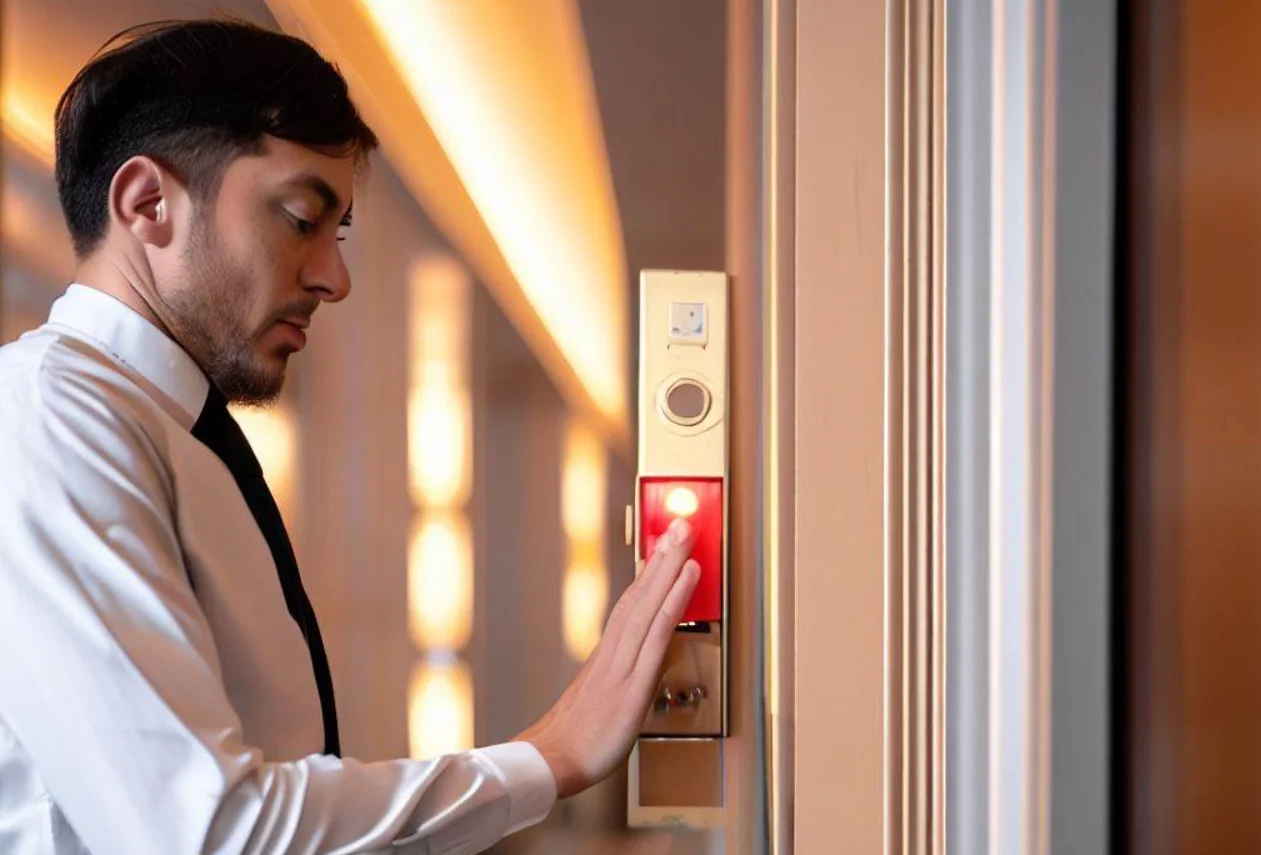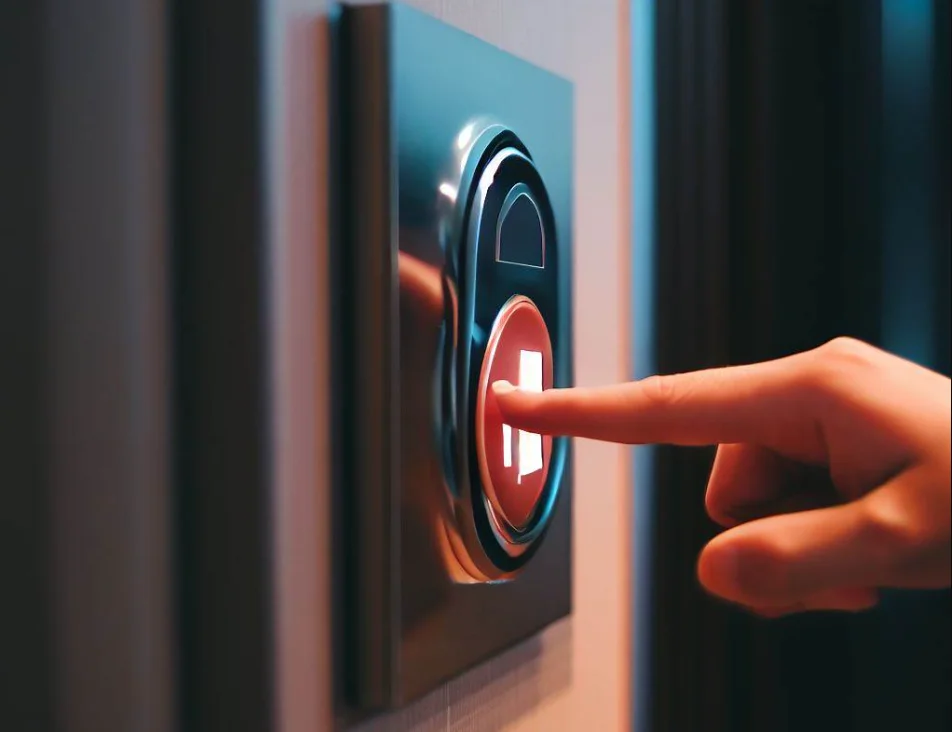Personal safety devices like duress buttons and panic buttons have become increasingly common in recent years. These small and inconspicuous buttons allow individuals to discreetly summon help in emergency situations.
Though the terms are sometimes used interchangeably, duress buttons and panic buttons have some key differences in how they function.
Understanding when to use each type of button can help maximize safety in environments like schools, hospitals, banks, retail stores and more. This comprehensive article from JET Hotel Solutions will examine what exactly duress buttons and panic buttons are, how they work, their key differences, and the optimal uses for each.
What is a Duress Button?
A duress button, also known as a duress alarm, is a silent personal safety device that allows individuals to surreptitiously notify authorities or monitoring services of an emergency. Duress buttons are designed to be subtle and easy to activate in tense situations where overtly calling for help could escalate the danger.
Duress buttons are wired devices that are installed in fixed locations, usually out of sight like under a counter or desk. When pressed, the button triggers a silent alarm to a central monitoring station or security team. This alerts them to the emergency without the perpetrator becoming aware, allowing for a more discreet response.

Duress buttons are common in public-facing businesses like banks, retail stores, hospitals and government buildings where employees could encounter threatening situations with customers or patients. They provide a way to get help without provoking or enraging someone already agitated or violent. The ability to silently signal distress can help defuse tense encounters and summon aid more safely.
What is a Panic Button?
A panic button serves a similar purpose to a duress button, but has some key differences. Panic buttons are designed to audibly alert occupants in a building that there is an emergency and to prompt evacuation or lockdown.
Panic buttons are installed in fixed locations, but when activated they trigger extremely loud alarms throughout the building. This immediately informs anyone present of potential danger like an active shooter, fire or other threat. The blaring alarm is meant to get the attention of occupants who can then take appropriate action depending on the protocol for different emergency types.
Panic buttons are commonly found in schools, manufacturing facilities, government buildings, hospitals and anywhere with a high occupancy of people. Their goal is maximum, building-wide notification of imminent danger so people can respond accordingly based on emergency training like evacuating or sheltering in place. The panic button’s audible warning removes reliance on PA systems or other forms of manual announcement in dire situations.
Key Differences Between Duress Buttons and Panic Buttons
While duress buttons and panic buttons both offer ways to summon emergency aid, their approaches are quite different:
- Duress buttons activate silently and are intended to surreptitiously notify authorities without the perpetrator knowing. Panic buttons activate extremely loud building-wide alarms to notify occupants of danger.
- Duress buttons alert a central monitoring service to provide discreet emergency dispatch. Panic buttons rely on audible alarms so occupants can take appropriate emergency action themselves.
- Duress buttons are ideal for defusing tense confrontations and getting help without provoking a perpetrator. Panic buttons are designed to create maximum disruption to alert occupants of immediate danger like an active shooter.
- Duress buttons can be tied into access control systems like those from JET Hotel Solutions for features like discrete door locking and unlocking. Panic buttons are standalone audible alarms not integrated with other systems.
- Duress buttons are solely for emergency communication to monitoring services or authorities. Panic buttons are mainly occupant notification devices, not direct lines of communication.
In summary, duress buttons provide silent, third-party monitored alarm activation, while panic buttons provide loud, self-activated building notification. Understandably, panic buttons are more commonly found in high occupancy facilities while duress buttons meet the needs of public-facing businesses.
Optimal Uses for Duress Buttons vs. Panic Buttons
When choosing what type of emergency activation system is right for a facility, consider the specific risks and population involved. Duress buttons and panic buttons each serve defined purposes that make them better suited for certain environments.
Duress buttons are ideal for locations like:
- Banks/retail stores: Allow employees to discreetly notify authorities of theft, robbery or an unruly customer.
- Hospitals/healthcare facilities: Let staff call for backup with aggressive patients without escalating a confrontation.
- Corporate offices: Enable employees to subtly signal an emergency like an armed intruder or domestic dispute.
- Government buildings: Allow employees to secretly notify security of a dangerous visitor or confrontation with the public.
- Remote worker safety: Provide home healthcare staff, social workers and other remote workers with emergency alert capabilities when out on calls.
Panic buttons are optimized for use in environments like:
- Schools: Immediately notify all occupants of emergencies and prompt lockdown or evacuation procedures.
- Manufacturing facilities: Quickly alert all workers of an active threat like a workplace shooting that necessitates evacuation or shelter.
- Government buildings/courthouses: Notify occupants including the public of immediate security threats like an armed perpetrator.
- Healthcare facilities: Sound building-wide alarms for emergencies like an active shooter that require immediate facility lockdown and shelter in place procedures.
- Hospitality/entertainment venues: Alert occupants of imminent dangers like an armed assailant that require panic lockdowns or mass evacuation.
Proper Selection, Training and Use
When selecting either duress buttons or panic buttons for a property, JET Hotel Solutions recommends working closely with security professionals to conduct thorough risk assessments of your facility. This will help determine if silent duress buttons for discreet monitoring or audible panic buttons for occupant alerting are the right solution.
Proper installation of these devices is also critical, as poorly placed buttons diminishes their effectiveness in an actual emergency. JET Hotel Solutions (https://www.jethotelsolutions.com/) emphasizes that user training for staff is also paramount so that individuals understand proper use cases and associated protocols.
Regular drills should also be conducted to keep personnel prepared if an emergency activation system is ever needed.
It’s also important to emphasize that duress and panic buttons should only be used in legitimate emergency situations and false activations can result in fines or other penalties. Protocols for responding to audible panic alarms or alerts from duress activations should be spelled out and distributed to both users and monitoring services.
With appropriate selection, installation, training and responsible use, duress and panic buttons can greatly enhance user safety when faced with threats like workplace violence, armed intruders and more.
In recent years, the tragic prevalence of public attacks has made these forms of emergency communication more relevant than ever.
Duress and Panic Buttons for Hotels and Resorts
For hotels and resorts, having emergency communication devices like duress or panic buttons can be prudent to protect both staff and guests.
High foot traffic public venues like lobbies, casinos, bars and meeting spaces can be sites of altercations, harassment or violence. Providing staff with silent duress button capabilities at reception desks, back offices and other posts can allow them to discreetly summon security or authorities. Duress buttons afford staff the ability to defuse an incident without further enraging an unruly patron.
Certain high risk areas like parking garages may also warrant panic buttons to notify guests of immediate danger like an active assailant. The loud audible alarms prompt rapid evacuation and notify security to respond.
Our company recommends thorough threat assessments to determine if any public hotel areas could benefit from panic button installation versus more subtle duress buttons for staff communication.
It’s critical that emergency devices be integrated properly with a hotel’s access control system to trigger lockdowns or unlocking as needed. JET Hotel Solutions (https://www.jethotelsolutions.com/) has experience seamlessly incorporating duress and panic buttons with a property’s existing security ecosystem to maximize the performance of these life saving tools.
Conclusion
Duress buttons and panic buttons both provide invaluable functionality when installed and used properly in facilities like hotels, hospitals, schools, retail stores and more.
Understanding the key differences in their silent monitored alerting vs. loud occupancy warning allows security managers to select the right solution for their specific risks and populations. With the proper emergency communication devices in place, staff and occupants can respond more decisively when faced with threats like workplace violence, armed intruders and other attacks.
JET Hotel Solutions (https://www.jethotelsolutions.com/) has the experience to advise and equip properties with effective duress and panic button systems tailored to their unique needs.


